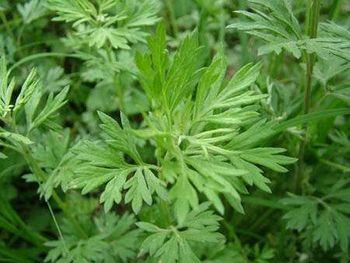Artemisia argyi
Artemisia argyi, the Chinese mugwort, is a herbaceous perennial plant in the composite family with a creeping rhizome. It can be found along open hillsides, grassy areas, and margin of forests. The best harvesting timing is from May to July when their leaves are in their utmost luxuriance while without blooming yet. Wormwood leaves are gathered on a warm dry day in spring and summer when the plant is in flower and dried in the shade. Drying in ventilated shade is the way for medicinal application. It is native to China, Japan, and far-eastern Siberia. It is used in herbal medicine for conditions of the liver, spleen and kidney. It is a common flavoring and colorant in the Chinese dish qingtuan.
Special Precautions of Artemisia argyi
The flavones eupatilin and jaceosidin may potently inhibit drugs metabolized by CYP1A2 (eg, several antidepressants and antipsychotics, some antibiotics) and CYP2C9 (numerous analgesic, antipyretic, anti-inflammatory, antiepileptic, statin, antidiabetic, anticoagulant, anticancer, antifungal, and antibacterial medications)
Health Benefits and uses of Artemisia argyi are
In traditional Chinese medicine, they are considered to have bitter, pungent and warm properties and to be associated with the liver, spleen and kidney meridians. It is bitter, acrid, and warm in nature. Main clinical usage and indications are spitting blood, nosebleed, menstrual disorders, hemafecia, uterine bleeding, period pain, bleeding during pregnancy, restless fetus, chest and abdomen pain due to cold, diarrhea and prolonged dysentery, abnormal vaginal discharge, eczema, sores and ringworm etc.
- The leaves are used as an antiseptic, expectorant, febrifuge and styptic.
- Cancer : Anticancer activity of flavones isolated from Chinese mugwort against several cancer cell lines has been documented in numerous in vitro and animal studies. However, clinical trials are lacking to support use in cancer treatment or prevention.
- The herb is considered to increase the blood supply to the pelvic region and stimulate menstruation, help treat infertility, dysmenorrhea, asthma and coughs.
- Another use is in moxibustion, a form of healing in which the herb is burned in cones or sticks or on the tip of an acupuncture needle. Boiling water can be poured onto the ground up leaves and used in a decoction, alone or with other substances, and the fresh leaf can be crushed and blended and a juice extracted.
- A volatile oil can be extracted from the leaves and used in the treatment of asthma and bronchitis for which purpose it is sprayed onto the back of the throat and brings rapid relief.
- The leaves have an antibacterial action and have been shown to be effective against Staphylococcus aureus, Bacillus dysenteriae, Bacillus subtilis, Bacillus typhi, Escherichia coli and Pseudomonas.
References
- Acupuncture Today: Mugwort Leaf
- Yeung. Him-Che. Handbook of Chinese Herbs and Formulas. Institute of Chinese Medicine, Los Angeles 1985
- Duke. J. A. and Ayensu. E. S. Medicinal Plants of China. Reference Publications, Inc. 1985 ISBN 0-917256-20-4
- Pan, JG; Xu, ZL; Ji, L (1992). "Chemical studies on essential oils from 6 Artemisia species". Zhongguo Zhong yao za zhi 17 (12): 741–4, 764. PMID 1304756.
